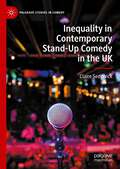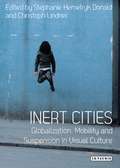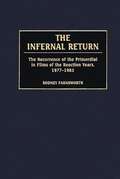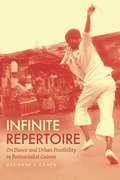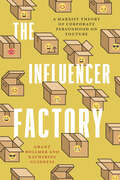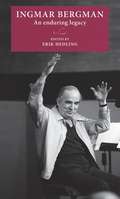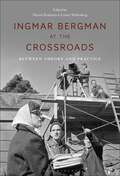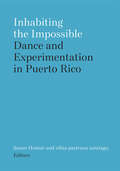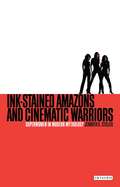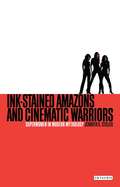- Table View
- List View
Indigenous Plots in Twenty-First Century Latin American Cinema
by Maria Chiara D'ArgenioIn this engaging book, Maria Chiara D’Argenio delineates a turn in recent Latin American filmmaking towards inter/cultural feature films made by non-Indigenous directors. Aimed at a global audience, but played by Indigenous actors, these films tell Indigenous stories in Indigenous languages. Over the last two decades, a growing number of Latin American films have screened the Indigenous experience by combining the local and the global in a way that has proved appealing at international film festivals. Locating the films in composite webs of past and present traditions and forms, Indigenous Plots in Twenty-First Century Latin American Cinema examines the critical reflection offered by recent inter/cultural films and the socio-cultural impact, if any, they might have had. Through the analysis of a selection of films produced between 2006 and 2019, the book gauges the extent to which non-Indigenous directors who set out to engage critically with colonial legacies and imaginaries, as well as with contemporary Indigenous marginalization, succeed in addressing these concerns by ‘unthinking’ and ‘undoing’ Western centrism and coloniality. Drawing on a wide range of disciplines and considering the entire cinematic process – from pre-production to the films’ production, circulation and critical reception – Indigenous Plots in Twenty-First Century Latin American Cinema makes the case for a holistic cultural criticism to explain the cultural and political work cinema does in specific historical contexts.
Indonesian Postcolonial Theatre: Spectral Genealogies and Absent Faces (Studies in International Performance)
by Evan Darwin WinetIndonesian Postcolonial Theatre explores modern theatrical practices in Indonesia from a performance of Hamlet in the warehouses of Dutch Batavia to Ratna Sarumpaet's feminist Muslim Antigones. The book reveals patterns linking the colonial to the postcolonial eras that often conflict with the historical narratives of Indonesian nationalism.
Inequality in Contemporary Stand-Up Comedy in the UK (Palgrave Studies in Comedy)
by Claire SedgwickThis Pivot explores the cultural economy of comedy in the UK, looking specifically at the links between industry practices and structures and who produces comedy in the UK. The research is based on interviews with comedians in the East Midlands; significantly, this demographic has been historically under-researched in studies of precarity, where the East Midlands is typically overlooked in discussions of arts funding and access in favour of a more simplistic north/south divide narrative. Similarly, whilst there has been increased discussion of the precarity of the creative and cultural industries, as well as media articles on the difficulty of breaking into comedy as a member of a marginalised group, there has been relatively little academic research to support this. While Friedman’s work in particular has been helpful for understanding the link between comedy producers, class and taste making, there has been less attention paid to the sociologies of work within comedy. This book fillsthese gaps in research by exploring the experiences of comedians in the East Midlands, contributing to the rich body of scholarship on inequality in the cultural industries and promoting a better understanding of the impact of structural inequalities and precarity on access to the cultural industries.
Inert Cities: Globalization, Mobility and Suspension in Visual Culture (International Library Of Visual Culture Ser.)
by Stephanie Hemelryk Donald Christoph LindnerWe usually associate contemporary urban life with movement and speed. But what about those instances when the forms of mobility associated with globalized cities – the flow of capital, people, labour and information – freeze, or decelerate? How can we assess the value of interruption in a city? What does valuing stillness mean in regards to the forward march of globalization? When does inertia presage decay - and when does it promise immanence and rebirth?Bringing together original contributions by international specialists from the fields of architecture, photography, film, sociology and cultural analysis, this cutting-edge book considers the poetics and politics of inertia in cities ranging from Amsterdam, Berlin, Beirut and Paris, to Beijing, New York, Sydney and Tokyo. Chapters explore what happens when photography, film, mixed media works, architecture and design intervene in public spaces and urban communities to disrupt speed and growth, both intellectually and/or practically; and question the degree to which mobility is aspirational or imaginary, absolute or transient. Together, they encourage a re-assessment of what it means to be urban in an unevenly globalizing world, to live in cities built around mythologies of perpetual progress. These new analyses of visual culture's strategic interruptions in global cities allow a more in-depth understanding of the new forms of space, experience, and community that are emerging in today's rapidly transforming urban environments.
Infectious Inequalities: Epidemics, Trust, and Social Vulnerabilities in Cinema
by Qijun Han Daniel R. CurtisThis book explores societal vulnerabilities highlighted within cinema and develops an interpretive framework for understanding the depiction of societal responses to epidemic disease outbreaks across cinematic history. Drawing on a large database of twentieth- and twenty-first-century films depicting epidemics, the study looks into issues including trust, distrust, and mistrust; different epidemic experiences down the lines of expertise, gender, and wealth; and the difficulties in visualizing the invisible pathogen on screen. The authors argue that epidemics have long been presented in cinema as forming a point of cohesion for the communities portrayed, as individuals and groups “from below” represented as characters in these films find solidarity in battling a common enemy of elite institutions and authority figures. Throughout the book, a central question is also posed: “cohesion for whom?”, which sheds light on the fortunes of those characters that are excluded from these expressions of collective solidarity. This book is a valuable reference for scholars and students of film studies and visual studies as well as academic and general readers interested in topics of films and history, and disease and society.
Infectious Inequalities: Epidemics, Trust, and Social Vulnerabilities in Cinema
by Qijun Han Daniel R. CurtisThis book explores societal vulnerabilities highlighted within cinema and develops an interpretive framework for understanding the depiction of societal responses to epidemic disease outbreaks across cinematic history. Drawing on a large database of twentieth- and twenty-first-century films depicting epidemics, the study looks into issues including trust, distrust, and mistrust; different epidemic experiences down the lines of expertise, gender, and wealth; and the difficulties in visualizing the invisible pathogen on screen. The authors argue that epidemics have long been presented in cinema as forming a point of cohesion for the communities portrayed, as individuals and groups “from below” represented as characters in these films find solidarity in battling a common enemy of elite institutions and authority figures. Throughout the book, a central question is also posed: “cohesion for whom?”, which sheds light on the fortunes of those characters that are excluded from these expressions of collective solidarity. This book is a valuable reference for scholars and students of film studies and visual studies as well as academic and general readers interested in topics of films and history, and disease and society.
The Infernal Return: The Recurrence of the Primordial in Films of the Reaction Years, 1977-1983
by Rodney FarnsworthGeorge Lukas and other leading filmmakers acknowledge their indebtedness to mythographic scholarship on archetypes. In his new study, author Rodney Farnsworth identifies a pattern of filmmakers' obsessions with archetypical rituals centered on sacrifice and the family in films made between 1977 and 1983, a period of political upheaval on both sides of the Atlantic. Combining a strong historical reading of the films in a sociopolitical context and utilizing Queer Theory as a framework for his arguments, Farnsworth offers a close examination of key films of the period, including works by Stanley Kubrick, Robert Altman, and Francis Ford Coppola, and provides a fascinating and timely glimpse of an important political and cinematic time.Marking the end of a more liberal era, the late seventies and early eighties witnessed the growth of reactionary conservative movements such as the New Religious Political Right. These were the years that gave birth to movies--from esoteric art-house pictures to blockbusters such as Star Wars--that seemed in many cases to be adaptations of primordial mythology, subverting liberal-to-moderate views into reactionary depictions of family life. Although filmmakers had turned to these myths to shape their works, Farnsworth observes, the unstable, volatile nature of the archetypes deconstructed their best social intentions into something rich, strange, and deadly. This thought-provoking work will be of interest to students of social history as well as film studies.
Infinite Repertoire: On Dance and Urban Possibility in Postsocialist Guinea
by Adrienne J. CohenIn Guinea’s capital city of Conakry, dance is everywhere. Most neighborhoods boast at least one dance troupe, and members of those troupes animate the city’s major rites of passage and social events. In Infinite Repertoire, Adrienne Cohen shows how dance became such a prominent—even infrastructural—feature of city life in Guinea, and tells a surprising story of the rise of creative practice under a political regime known for its authoritarianism and violent excesses. Guinea’s socialist state, which was in power from 1958 to 1984, used staged African dance or “ballet” strategically as a political tool, in part by tapping into indigenous conceptualizations of artisans as powerful figures capable of transforming the social fabric through their manipulation of vital energy. Far from dying with the socialist revolution, Guinean ballet continued to thrive in Conakry after economic liberalization in the 1980s, with its connection to transformative power retrofitted for a market economy and a rapidly expanding city. Infinite Repertoire follows young dancers and percussionists in Conakry as they invest in the present—using their bodies to build a creative urban environment and to perform and redefine social norms and political subjectivities passed down from the socialist generation before them. Cohen’s inventive ethnography weaves the political with the aesthetic, placing dance at the center of a story about dramatic political change and youthful resourcefulness in one of the least-studied cities on the African continent.
Infinite Repertoire: On Dance and Urban Possibility in Postsocialist Guinea
by Adrienne J. CohenIn Guinea’s capital city of Conakry, dance is everywhere. Most neighborhoods boast at least one dance troupe, and members of those troupes animate the city’s major rites of passage and social events. In Infinite Repertoire, Adrienne Cohen shows how dance became such a prominent—even infrastructural—feature of city life in Guinea, and tells a surprising story of the rise of creative practice under a political regime known for its authoritarianism and violent excesses. Guinea’s socialist state, which was in power from 1958 to 1984, used staged African dance or “ballet” strategically as a political tool, in part by tapping into indigenous conceptualizations of artisans as powerful figures capable of transforming the social fabric through their manipulation of vital energy. Far from dying with the socialist revolution, Guinean ballet continued to thrive in Conakry after economic liberalization in the 1980s, with its connection to transformative power retrofitted for a market economy and a rapidly expanding city. Infinite Repertoire follows young dancers and percussionists in Conakry as they invest in the present—using their bodies to build a creative urban environment and to perform and redefine social norms and political subjectivities passed down from the socialist generation before them. Cohen’s inventive ethnography weaves the political with the aesthetic, placing dance at the center of a story about dramatic political change and youthful resourcefulness in one of the least-studied cities on the African continent.
The Influencer Factory: A Marxist Theory of Corporate Personhood on YouTube
by Grant Bollmer Katherine GuinnessInfluencers are more than social media personalities who attract attention for brands, argue Grant Bollmer and Katherine Guinness. They are figures of a new transformation in capitalism, in which the logic of the self is indistinguishable from the logic of the corporation. Influencers are emblematic of what Bollmer and Guinness call the "Corpocene": a moment in capitalism in which individuals achieve the status of living, breathing, talking corporations. Behind the veneer of leisure and indulgence, most influencers are laboring daily, usually for pittance wages, to manufacture a commodity called "the self"—a raw material for brands to use—with the dream of becoming corporations in human form by owning and investing in the products they sell. Refuting the theory that digital labor and economies are immaterial, Bollmer and Guinness search influencer content for evidence of the material infrastructure of capitalism. Each chapter looks to what literally appears in the backgrounds of videos and images: the houses, cars, warehouses, and spaces of the market that point back to the manufacturing and circulation of consumer goods. Demonstrating the material reality of producing the self as a commodity, The Influencer Factory makes a crucial contribution to our understanding of contemporary economic life.
The Influencer Factory: A Marxist Theory of Corporate Personhood on YouTube
by Grant Bollmer Katherine GuinnessInfluencers are more than social media personalities who attract attention for brands, argue Grant Bollmer and Katherine Guinness. They are figures of a new transformation in capitalism, in which the logic of the self is indistinguishable from the logic of the corporation. Influencers are emblematic of what Bollmer and Guinness call the "Corpocene": a moment in capitalism in which individuals achieve the status of living, breathing, talking corporations. Behind the veneer of leisure and indulgence, most influencers are laboring daily, usually for pittance wages, to manufacture a commodity called "the self"—a raw material for brands to use—with the dream of becoming corporations in human form by owning and investing in the products they sell. Refuting the theory that digital labor and economies are immaterial, Bollmer and Guinness search influencer content for evidence of the material infrastructure of capitalism. Each chapter looks to what literally appears in the backgrounds of videos and images: the houses, cars, warehouses, and spaces of the market that point back to the manufacturing and circulation of consumer goods. Demonstrating the material reality of producing the self as a commodity, The Influencer Factory makes a crucial contribution to our understanding of contemporary economic life.
Information Inequality
by Herbert SchillerHerbert Schiller, long one of America's leading critics of the communications industry, here offers a salvo in the battle over information. In Information Inequality he explains how privatization and the corporate economy directly affect our most highly prized democratic institutions: schools and libraries, media, and political culture. A master media-watcher, Schiller presents a crisp and far-reaching indictment of the "data deprivation" corporate interests are inflicting on the social fabric.
Information Inequality
by Herbert SchillerHerbert Schiller, long one of America's leading critics of the communications industry, here offers a salvo in the battle over information. In Information Inequality he explains how privatization and the corporate economy directly affect our most highly prized democratic institutions: schools and libraries, media, and political culture. A master media-watcher, Schiller presents a crisp and far-reaching indictment of the "data deprivation" corporate interests are inflicting on the social fabric.
Ingmar Bergman: An enduring legacy (Lund University Press)
by Erik HedlingThis unique collection focuses on the work of legendary Swedish filmmaker Ingmar Bergman. Written in the wake of the centenary of Bergman’s birth in 2018, the volume aims to combine new approaches to Bergman’s films and writings with more traditional analyses. Established themes such as Bergman’s interest in philosophy and psychology are addressed, but also less familiar topics, notably his relationship with Hollywood and his elaborate use of film music and autobiographical writing that characterised his later work. There are new analyses of aspects of Bergman’s most famous films, including Smiles of a Summer Night and Fanny and Alexander, but also insightful readings of lesser-known works, such as Saraband and Sawdust and Tinsel.
Ingmar Bergman: An enduring legacy (Lund University Press)
by Erik HedlingThis unique collection focuses on the work of legendary Swedish filmmaker Ingmar Bergman. Written in the wake of the centenary of Bergman’s birth in 2018, the volume aims to combine new approaches to Bergman’s films and writings with more traditional analyses. Established themes such as Bergman’s interest in philosophy and psychology are addressed, but also less familiar topics, notably his relationship with Hollywood and his elaborate use of film music and autobiographical writing that characterised his later work. There are new analyses of aspects of Bergman’s most famous films, including Smiles of a Summer Night and Fanny and Alexander, but also insightful readings of lesser-known works, such as Saraband and Sawdust and Tinsel.
Ingmar Bergman: The Life and Films of the Last Great European Director
by Geoffrey MacnabIngmar Bergman was the last and arguably the greatest of the old-style European auteurs and his influence across all areas of contemporary cinema has continued to be considerable since his death in July 2007. Drawing on interviews with collaborators and original research, this book puts Bergman's career into the context of his life and offers a new and revealing portrait of this great filmmaker. Geoffrey Macnab explores the often painfully autobiographical nature of his work, while also looking in detail at Bergman as a craftsman. He considers Bergman's working relationship with his actors (especially the actresses he helped make into international stars), his passion for theatre, literature and classical music and his obsession with death and cruelty.The book traces his traumatic childhood, asking how his experiences growing up as the son of a strict Lutheran pastor fed into his later writing and filmmaking. It also looks at his political life, chronicling his teenage flirtation with Nazi-sm, his bitter spat in the mid-70s with the Swedish authorities over his tax affairs and his often vexed relationship with his fellow Swedes. Geoffrey Macnab also considers how Bergman's work was financed and distributed, his relationship with US agents and how close he came to working in Hollywood.'When I was 10 years old I received my first rattling film projector with its chimney and lamp which went round and round and round. I found it both mystifying and fascinating' - Ingmar Bergman
Ingmar Bergman at the Crossroads: Between Theory and Practice
by Maaret Koskinen and Louise WallenbergIngmar Bergman's rich legacy as film director and writer of classics such as The Seventh Seal, Scenes From a Marriage, and Fanny and Alexander has attracted scholars not only in film studies but also of literature, theater, gender, philosophy, religion, sociology, musicology, and more. Less known, however, is Bergman from the perspective of production studies, including all the choices, practices, and routines involved in what goes on behind the scenes. For instance, what about Bergman's collaborations and conflicts with film producers? What about his work with musicians at the opera, technicians in the television studio, and actors on the film set. What about Bergman and MeToo? In order to throw light on these issues, art practitioners such as film directors Ang Lee and Margarethe von Trotta, film and opera director Atom Egoyan, and film producer and screenwriter James Schamus are brought together with academics such as philosopher and film scholar Paisley Livingston, musicologist Alexis Luko, and playwright and performance studies scholar Allan Havis to discuss Bergman's work from their unique perspectives. In addition, Ingmar Bergman at the Crossroads provides, for the first time, in-depth interviews with Bergman's longtime collaborators Katinka Faragó and Måns Reuterswärd, who both have first-hand experience of working intimately as producers in film and television with Bergman, covering more than 5 decades. In an open exchange between individual and institutional perspectives, this book bridges the often-rigid boundaries between theoreticians and practitioners, in turn pointing Bergman studies in new directions.
Ingmar Bergman at the Crossroads: Between Theory and Practice
Ingmar Bergman's rich legacy as film director and writer of classics such as The Seventh Seal, Scenes From a Marriage, and Fanny and Alexander has attracted scholars not only in film studies but also of literature, theater, gender, philosophy, religion, sociology, musicology, and more. Less known, however, is Bergman from the perspective of production studies, including all the choices, practices, and routines involved in what goes on behind the scenes. For instance, what about Bergman's collaborations and conflicts with film producers? What about his work with musicians at the opera, technicians in the television studio, and actors on the film set. What about Bergman and MeToo? In order to throw light on these issues, art practitioners such as film directors Ang Lee and Margarethe von Trotta, film and opera director Atom Egoyan, and film producer and screenwriter James Schamus are brought together with academics such as philosopher and film scholar Paisley Livingston, musicologist Alexis Luko, and playwright and performance studies scholar Allan Havis to discuss Bergman's work from their unique perspectives. In addition, Ingmar Bergman at the Crossroads provides, for the first time, in-depth interviews with Bergman's longtime collaborators Katinka Faragó and Måns Reuterswärd, who both have first-hand experience of working intimately as producers in film and television with Bergman, covering more than 5 decades. In an open exchange between individual and institutional perspectives, this book bridges the often-rigid boundaries between theoreticians and practitioners, in turn pointing Bergman studies in new directions.
Ingrid Bergman (Great Stars)
by David Thomson'Ingrid Bergman was far more than just a sweet, virtuous, "natural" Swedish girl - she was a dark sensualist over whom many men might go mad. Her very gaze delivered a climate of adult romantic expectation.'Adored by millions for her luminous beauty and elegance, at the height of her career Ingrid Bergman commanded a love that has hardly ever been matched, until her marriage fell apart and created an international scandal. Here renowned film writer David Thomson gives his own unique and original take on a woman who was constantly driven by her passions and by her need to act, even if it meant sacrificing everything.
Inhabiting the Impossible: Dance and Experimentation in Puerto Rico (Studies in Dance: Theories and Practices)
by Susan Homar and nibia pastrana santiagoThis first-of-its-kind book brings together writing by artists and scholars to survey the lively field of Puerto Rican experimental dance across four decades. Originally published as Habitar lo Imposible, the translation in English features essays, artist statements, and interviews plus more than 100 photos of productions, programs, posters, and scores. Throughout, Inhabiting the Impossible provides fresh, invaluable perspectives on experimentation in dance as a sustained practice that has from the start deeply engaged issues of race, gender, sexuality, and politics. The book is also enhanced by a bibliographic section with detailed resources for further study.
Inherited Risk: Errol and Sean Flynn in Hollywood and Vietnam.
by Jeffrey MeyersAn extraordinary father-son biography of the scandalous life of movie star Errol Flynn and of his son's equally glamorous yet doomed career as a war photographer in Vietnam.
Inhospitable World: Cinema in the Time of the Anthropocene
by Jennifer FayIn recent years, environmental and human rights advocates have suggested that we have entered the first new geological epoch since the end of the ice age: the Anthropocene. In this new epoch, humans have come to reshape unwittingly both the climate and natural world; humankind has caused mass extinctions of plant and animal species, polluted the oceans, and irreversibly altered the atmosphere. Ironically, our efforts to make the planet more hospitable to ourselves seem to be driving us toward our inevitable extinction. A force of nature, humanity is now decentered as the agent of history. As Jennifer Fay argues, this new situation is to geological science what cinema has always been to human culture. Film, like the Anthropocene, is a product of the industrial revolution, but arises out of a desire to preserve life and master time and space. It also calls for the creation of artificial worlds, unnatural weather, and deadly environments for entertainment, scientific study, and devising military strategy. Filmmaking stages, quite literally, the process by which worlds and weather come into being and meaning, and it mimics the forces that are driving this new planetary inhospitality. Cinema, in other words, provides an image of "nature" in the age of its mechanical reproducability. Fay argues that cinema exemplifies the philosophical, political, and perhaps even logistical processes by which we can adapt to these forces and also imagine a world without humans in it. Whereas standard ecological criticism attends to the environmental crisis as an unraveling of our natural state, this book looks to film (from Buster Keaton, to Jia Zhangke, to films of atomic testing and early polar exploration) to consider how it reflects upon the creation and destruction of human environments. What are the implications of ecological inhospitality? What role might cinema and media theory play in challenging our presumed right to occupy and populate the world? As an art form, film enjoys a unique relationship to the material, elemental world it captures and produces. Through it, we may appreciate the ambitions to design an unhomely planet that may no longer accommodate us.
INHOSPITABLE WORLD C: Cinema in the Time of the Anthropocene
by Jennifer FayIn recent years, environmental and human rights advocates have suggested that we have entered the first new geological epoch since the end of the ice age: the Anthropocene. In this new epoch, humans have come to reshape unwittingly both the climate and natural world; humankind has caused mass extinctions of plant and animal species, polluted the oceans, and irreversibly altered the atmosphere. Ironically, our efforts to make the planet more hospitable to ourselves seem to be driving us toward our inevitable extinction. A force of nature, humanity is now decentered as the agent of history. As Jennifer Fay argues, this new situation is to geological science what cinema has always been to human culture. Film, like the Anthropocene, is a product of the industrial revolution, but arises out of a desire to preserve life and master time and space. It also calls for the creation of artificial worlds, unnatural weather, and deadly environments for entertainment, scientific study, and devising military strategy. Filmmaking stages, quite literally, the process by which worlds and weather come into being and meaning, and it mimics the forces that are driving this new planetary inhospitality. Cinema, in other words, provides an image of "nature" in the age of its mechanical reproducability. Fay argues that cinema exemplifies the philosophical, political, and perhaps even logistical processes by which we can adapt to these forces and also imagine a world without humans in it. Whereas standard ecological criticism attends to the environmental crisis as an unraveling of our natural state, this book looks to film (from Buster Keaton, to Jia Zhangke, to films of atomic testing and early polar exploration) to consider how it reflects upon the creation and destruction of human environments. What are the implications of ecological inhospitality? What role might cinema and media theory play in challenging our presumed right to occupy and populate the world? As an art form, film enjoys a unique relationship to the material, elemental world it captures and produces. Through it, we may appreciate the ambitions to design an unhomely planet that may no longer accommodate us.
Ink-stained Amazons and Cinematic Warriors: Superwomen in Modern Mythology
by Jennifer K. StullerFrom "Wonder Woman" to Buffy Summers, Emma Peel to Sydney Bristow, "Charlie's Angels" to "The Powerpuff Girls", Superwomen are more than just love interests or sidekicks who stand by their Supermen. In her new book, Stuller shows how the female hero in modern mythology has broken through the boy's club barrier of tradition and reveals the pivotal role of high-heeled crime fighters in popular culture.Featuring spies and sexuality, daddy's girls and super-mothers, this is a comprehensive, engaging and thought-provoking guide to female detectives, meta-humans and action heroines, as well as their creators, directors, performers, and consumers. The book also includes a glossary of modern mythic women, from Aeon to Zoe, as well as a foreword by acclaimed cultural commentator Roz Kaveney, author of "Superheroes! Capes and Crusaders in Comics and Films" (published by I.B. Tauris, April 2008).
Ink-stained Amazons and Cinematic Warriors: Superwomen in Modern Mythology
by Jennifer K. StullerIn 'Ink-stained Amazons and Cinematic Warriors', author Jennifer Stuller looks at the role of superwomen in modern mythology, tracing their development in comics, in films and on television over the course of the past seven decades. From Wonder Woman to Buffy Summers, Emma Peel to Sydney Bristow, Charlie's Angels to The Powerpuff Girls, Superwomen are more than just love interests or sidekicks who stand by their Supermen. In her new book, Stuller shows how the female hero in modern mythology has broken through the boy's club barrier of tradition and reveals the pivotal role of high-heeled crimefighters in popular culture. Featuring spies and sexuality, daddy's girls and super-mothers, this is a comprehensive, engaging and thought-provoking guide to female detectives, meta-humans and action heroines, as well as their creators, directors, performers, and consumers. The book also includes a glossary of modern mythic women, from Aeon to Zoë, as well as a foreword by acclaimed cultural commentator Roz Kaveney, author of 'Superheroes! Capes and Crusaders in Comics and Films' (published by I.B.Tauris, April 2008).


